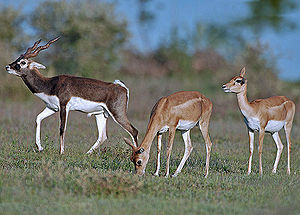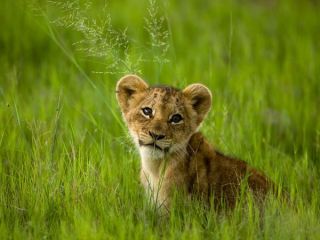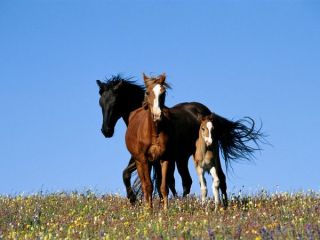Antelope is a term referring to many even-toed ungulate species indigenous to various regions in Africa and Eurasia. Antelopes comprise a miscellaneous group within the family Bovidae, encompassing those old-world species that are neither cattle, sheep, buffalo, bison, nor goats. A group of antelope is called a herd.
Distinctions from confusingly similar even-toed ungulates :
 No antelope species are native to Australasia, or Antarctica. Nor do any extant species occur in the Americas, though at least one saiga species occurred in parts of North America during the Pleistocene. The Pronghorn of North America, though sometimes known colloquially as Pronghorn Antelope, is not a member of the family Bovidae, but the family Antilocapridae and accordingly is not a true antelope. Among their most obvious differences, pronghorns have branching horns, of which they shed the outer horny sheaths annually, in which they in turn differ from deer. The horns of pronghorns and the antlers of deer contrast in two ways with the horns of true antelopes; firstly, although true antelopes have horns of various shapes according to species, whether straight, curved, helical, or otherwise, and although their horns have cores of living bone, their horns always are unbranched. Secondly, the antelope horn never is shed, either wholly as in the antlers of deer, nor in part, as in the pronghorn.
No antelope species are native to Australasia, or Antarctica. Nor do any extant species occur in the Americas, though at least one saiga species occurred in parts of North America during the Pleistocene. The Pronghorn of North America, though sometimes known colloquially as Pronghorn Antelope, is not a member of the family Bovidae, but the family Antilocapridae and accordingly is not a true antelope. Among their most obvious differences, pronghorns have branching horns, of which they shed the outer horny sheaths annually, in which they in turn differ from deer. The horns of pronghorns and the antlers of deer contrast in two ways with the horns of true antelopes; firstly, although true antelopes have horns of various shapes according to species, whether straight, curved, helical, or otherwise, and although their horns have cores of living bone, their horns always are unbranched. Secondly, the antelope horn never is shed, either wholly as in the antlers of deer, nor in part, as in the pronghorn.
Apart from not shedding their horns, antelope, and bovids in general, differ from deer in several other ways. Probably the most obvious is that their horns are perennial living bone covered with strong, thick layers of dead horn tissue, whereas antlers, in those deer that have them, are covered with living skin (“velvet”) only while growing. The velvet then is shed and the bony tissue, after it has matured, dies and is shed at the end of the season.
Etymology :
The English word “antelope” first appears in 1417 and is derived from the Old French antelop, itself derived from Medieval Latin ant(h)alopus, which in turn comes from the Byzantine Greek word anthólops, first attested in Eustathius of Antioch (c.336), according to whom it was a fabulous animal “haunting the banks of the Euphrates, very savage, hard to catch and having long saw-like horns capable of cutting down trees”.[2] It perhaps derives from Greek anthos (flower) and ops (eye), perhaps meaning “beautiful eye” or alluding to the animals long eyelashes; however this may be a later folk etymology. The word talopus and calopus, from Latin, came to be used in heraldry. In 1607 it was first used for living, cervine animals.
Species :
There are 91 species, most of which are native to Africa, in about 30 genera. The classification of tribes or subfamilies within Bovidae is still a matter of debate, with several alternative systems proposed.
Antelope are not a cladistic or taxonomically defined group. The term is used loosely to describe all members of the family Bovidae which do not fall under the category of sheep, cattle, or goat. Usually all species of the Alcelaphinae, Antilopinae, Hippotraginae, Reduncinae, Cephalophinae, many Bovinae, the Grey Rhebok, and the impala are called antelopes
Distribution and habitat :
Most species of antelope are native to Africa, but some occur in Asia. The Arabian Peninsula is home to the Arabian Oryx and Dorcas Gazelle. India is home to the Nilgai, Chinkara, and Blackbuck, while Russia and Central Asia have the Four-horned Antelope, Tibetan antelope, and Saiga Antelope.
Many species of antelope have been imported to other parts of the world, especially the United States, for exotic game hunting. Due to the spectacular leaping and evasive skills of some species, individuals may escape. Texas in particular has high numbers of gaming ranches, as well as habitat and climate that are very hospitable to African and Asian plains antelope species. As such, wild populations of Blackbuck Antelope, Gemsbok, and Nilgai exist in Texas, though they are not native to the area.
Antelope exist in a wide range of habitats. Numerically, most exist in the African savannahs. However, there are many species of more secluded forest antelope, as well as the extreme-cold living Saiga, desert adapted Arabian Oryx, the rocky kopje-living klipspringer, and semi-aquatic sitatunga.
Species of forest, woodland, or bush tend to be sedentary, but many of the plains species undertake huge migrations. These migrations enable grass-eating species to follow the rains and therefore their food supply. The gnus and gazelles of East Africa perform some of the most impressive mass migratory circuits of all mammals.
Morphology :
All bovids have even-toed hooves, horizontal pupils, ruminating guts, and (in at least the males) bony horns. These basic characteristics, however, mask huge differences in appearance between antelopes, cattle, goats, and sheep, and among the antelopes themselves.[6] For example, a male Common Eland can measure 178 centimetres (70 in) at the shoulder and weigh almost 950 kilograms (2,100 lb), whereas an adult Royal Antelope may stand only 24 centimetres (9.4 in) at the shoulder and weigh a mere 1.5 kilograms (3.3 lb).
Not surprisingly for animals with long, slender yet powerful legs, many antelopes have long strides and can run fast. Some (e.g. Klipspringer) are also adapted to climbing in rock kopjes. Both Dibatags and Gerenuks habitually stand on their two hind legs to reach acacia and other tree foliage. Different antelope have different body types which can affect movement. Duikers are short, bush-dwelling antelope that can pick through dense foliage and dive into the shadows rapidly. Gazelles and Springbok are known for their speed and leaping abilities. Even larger antelope, such as Nilgai, Elands, and Kudus, are capable of jumping 8 feet (2.4 m) or greater, although their running speed is restricted by their greater mass.
Antelopes have a wide variety of coverings, through most have a dense coat of short fur. In most species, the coat (pelage) is some variation of a brown colour (or several shades of brown); often with white or pale under-bodies. Exceptions include the zebra-marked Zebra Duiker; the grey, black, and white Jentink’s Duiker; and the Black Lechwe. Most of the “spiral-horned” antelopes have pale vertical stripes on their backs. Many desert and sub-desert species are particularly pale, some almost silvery or whitish (e.g. Arabian Oryx); the Beisa and Southern Oryxes have gray and black pelage with vivid black-and-white faces. Common features of various gazelles are a white rump, which flashes a warning to others when they run from danger, and a dark stripe mid-body (the latter feature is also shared by the Springbok and Beira). The Springbok also has a pouch of white brushlike hairs running along its back, which opens up when the animal senses danger, causing the dorsal hairs to stand on end.
Antelopes are ruminants, and thus have well-developed molar teeth, which grind cud (food balls stored in the stomach) into a pulp for further digestion. They have no upper incisors, but rather a hard upper gum pad, against which their lower incisors bite to tear grass stems and leaves.
Like many other herbivores, antelopes rely on keen senses to avoid predators. Their eyes are placed on the sides of their heads, giving them a broad radius of vision with minimal binocular vision. The fact that most species have their pupils elongated horizontally also helps in this respect. Acute senses of smell and hearing, give antelope the ability to perceive danger at night out in the open (when predators are often on the prowl). These same senses play an important role in contact between individuals of the same species: markings on head, ears, legs, and rumps are used in such communication—many species “flash” such markings, as well as their tails; vocal communications include loud barks, whistles, “moos” and trumpeting; many species also use scent marking to define their territories or simply to maintain contact with their relatives and neighbors.
Many antelope are sexually dimorphic. In most species, both sexes have horns, but those of males tend to be larger. There is a tendency for males to be larger than the females; however, exceptions in which the females tend to be heavier than the males include the Bush Duiker, Dwarf Antelope, Cape Grysbok, and Oribi, all rather small species. A number of species have hornless females (e.g. Sitatunga, Red Lechwe, and Suni). In some species, the males and females have different coloured pelage (e.g. Blackbuck and Nyala).
The size and shape of antelope horns varies immensely. Those of the duikers and dwarf antelopes tend to be simple “spikes”, but differ in the angle to the head from backward curved and backward pointing (e.g. Yellow-backed Duiker) to straight and upright (e.g. Steenbok). Other groups have twisted (e.g. Common Eland), spiral (e.g. Greater Kudu), “recurved” (e.g. the reedbucks), lyrate (e.g. impala), or long, curved (e.g. the oryxes) horns. Horns are not shed and their bony core is covered with a thick, persistent sheath of horny material, both of which features distinguish them from antlers.
Horns are efficient weapons and tend to be better developed in those species where males fight over females (large herd antelope) than in solitary or lekking species. With male-male competition for mates, horns are clashed in combat. It is much more common for males to use their horns against each other than against another species. The boss of the horns is typically arranged in such a way that two antelope striking at each other’s horns cannot crack each other’s skulls, making a fight via horn more ritualized than dangerous. Many species have ridges in their horns for at least 2/3 the length of their horns, but these ridges are not a direct indicator of age
Behavior :
Mating strategies :
Antelope are often classified by their reproductive behavior.
Small antelope, such as dik-diks, tend to be monogamous. They live in a forest environment with patchy resources, and a male is unable to monopolize more than one female due to this sparse distribution. Larger forest species often form very small herds of 2–4 females and 1 male.
Some species such as lechwe pursue a lek breeding system. In this, the males gather on a lekking ground and compete for a small territory, while the females appraise males and choose one with which to mate.
Large grazing antelope, such as impala or wildebeest form large herds made up of many females and a single breeding male, which excludes all other males, often by combat.
Defence :
Antelope pursue a number of defense strategies, often dictated by their morphology.
 Large antelope that gather in large herds, such as wildebeest rely on numbers and running speed for protection. In some species, adults will circle around the offspring, protecting them from predators when threatened. Many forest antelope rely on cryptic coloring and good hearing to avoid predators. Forest antelope often have very large ears and a dark or striped coloration. Small antelope, especially duikers, evade predation by jumping into dense bush where the predator cannot pursue. Springboks use a behavior known as stotting to confuse predators.
Large antelope that gather in large herds, such as wildebeest rely on numbers and running speed for protection. In some species, adults will circle around the offspring, protecting them from predators when threatened. Many forest antelope rely on cryptic coloring and good hearing to avoid predators. Forest antelope often have very large ears and a dark or striped coloration. Small antelope, especially duikers, evade predation by jumping into dense bush where the predator cannot pursue. Springboks use a behavior known as stotting to confuse predators.
Open grassland species have nowhere to hide from predators so they tend to be fast runners. They are agile and have good endurance—these are advantages when pursued by sprint-dependent predators like cheetah, which are the fastest of land animals but tire quickly. Reaction distances vary with predator species and predator behaviour. For example, gazelles may not flee from a lion until it is closer than 200 m (650 ft)—lions hunt as a pride or by surprise, usually by stalking, one that can be seen clearly is unlikely to attack. However, sprint-dependent cheetahs will cause gazelles to flee at a range of over 800 m (0.5 mile).
Status :
About 25 species are rated by the IUCN as endangered, such as the Dama Gazelle and Mountain Nyala. A number of subspecies are also endangered, including the Giant Sable Antelope and mhorr gazelle. The main causes for concern for these species are habitat loss, competition with cattle for grazing, and trophy hunting.
The chiru or Tibetan antelope is hunted for its pelt, which is used in making shahtoosh, an incredibly fine material used in shawls. The fur can only be removed from dead animals, and each animal yields very little of the downy fur, so multiple antelope must be killed to make a single shawl. This unsustainable demand has led to enormous declines in the chiru population.
The Saiga Antelope is hunted for its horns, which are considered an aphrodisiac by some cultures. Only the males carry the horns, and have been heavily hunted to the point where some herds contain up to 800 females and a single male. The species has shown a steep decline and is critically endangered.
Lifespan :
It is difficult to determine how long antelope live in the wild. With the preference of predators towards old and infirm individuals which can no longer sustain peak speeds, few wild prey-animals live as long as their biological potential. In captivity, wildebeest have lived beyond 20 years old, and impalas have reached their late teens. In the wild, few individuals of prey species live to old age, as the old and weak are easier prey for predators; antelopes are no exception to this rule
Humans :
Culture :
The antelope’s horn is prized for medicinal and magical powers in many places. The horn of the male Saiga in Eastern practice is ground as an aphrodisiac, for which it has been hunted nearly to extinction. In the Congo, it is thought to confine spirits. Christian iconography sometimes uses the antelope’s two horns as a symbol of the two spiritual weapons that Christians possess: the Old Testament and the New Testament. Their ability to run swiftly has also led to their association with the wind, such as in the Rig Veda, as the steeds of the Maruts and the wind god Vayu.
Domestication :
Domestication of animals requires certain traits in the animal which antelope do not typically display. Most species are difficult to contain in any density, due to territoriality of males or in the case of oryxes (which have a relatively hierarchical social structure), an aggressive disposition that can easily kill a human. Because many have extremely good jumping abilities, providing adequate fencing is a challenge. Also, antelope will consistently display a fear response to perceived predators, such as humans, making them very difficult to herd or handle. Although antelopes have a diet and rapid growth rate highly suitable for domestication, this tendency to panic and their non-hierarchical social structure explains why farm-raised antelope is uncommon. Ancient Egyptians kept herds of gazelles for meat, and occasionally pets. It is unknown whether they were truly domesticated, but it seems unlikely as no domesticated gazelles exist today.
However, humans have had success taming certain species, such as the elands. These antelope sometimes jump over each other’s backs when alarmed, but this incongruous talent seems to be exploited only by wild members of the species; tame elands do not take advantage of it and can be enclosed within a very low fence. Their meat, milk, and hides are all of excellent quality, and experimental eland husbandry has been going on for some years in both Ukraine and Zimbabwe. In both locations the animal has proved wholly amenable to domestication. For further information, see animal domestication.
Hybrid antelope :
A wide variety of antelope hybrids have been recorded in zoos, game parks, and wildlife ranches. This is due to either a lack of more appropriate mates in enclosures shared with other species or a misidentification of species. The ease of hybridization shows how closely related some antelope species are. With few exceptions, most hybrid antelope occur only in captivity.
Most hybrids occur between species within the same genus. All reported examples occur within the same sub-family. As with most mammal hybrids, the less closely related the parents, the more likely that the offspring will be sterile
taken from :http://en.wikipedia.org












